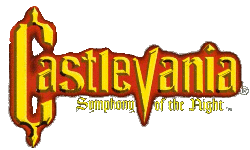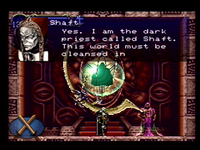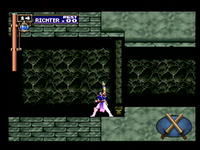|
|

|
BATTLE SYSTEM
|

|
INTERACTION
|

|
ORIGINALITY
|

|
STORY
|

|
MUSIC & SOUND
|

|
VISUALS
|

|
CHALLENGE
|
Easy to Medium
|
COMPLETION TIME
|
10-20 Hours
|
|
OVERALL
4.0/5
|
Rating definitions
|
|
|
Many people fell in love with the recent Castlevania games on Nintendo handheld systems that combine challenging gameplay with a castle to explore. Most of those people probably cut their teeth on Castlevania: Symphony of the Night on the original PlayStation, but for those that missed their chance to play this classic years ago or wish to take Alucard through Dracula's castle again, Konami brings the title back on the Live Arcade.
Unlike the games that followed it, SotN stars Alucard, the son of Dracula, as he attempts to foil the plans of the evil shaman Shaft; he intends to revive his vanquished lord, Dracula. To prevent this, Alucard has awakened from his long slumber to enter his father's castle and keep the world from falling into evil's grasp. As with other games in the series, the plot isn't very deep, and it's never really expected to be. The main focus is exploring castle and battling the many monsters and demons that dwell within it to yeild experience points.
Prior to the release of SotN, the series consisted almost entirely of very challenging platformers. This game introduced the idea of exploring a castle from top to bottom, and after it looks like the place has been completely searched, a second, inverted castle is opened up to further extend the game. Though the exploration theme originated in Castlevania II: Simon's Quest, Symphony of the Night refined and perfected it to make it such an enjoying experience. For instance, the castle is full of obstacles that require a special item or ability to get by. Usually, killing a boss will yield this power, and then an entirely new section of the castle will open up for exploration.
 You see this cat Shaft is a bad mother-- No really. He is. He's this game's villain.
You see this cat Shaft is a bad mother-- No really. He is. He's this game's villain.
|
|
Combat maps relatively well to the Xbox 360's controller with the shoulder buttons allowing Alucard to change into his three other forms and the remaining shoulder button for the automap. Movement can be done with either the left analog stick or the d-pad, and both work relatively well. The only flaw is that the analog stick seems to have trouble hitting diagonals for some attacks, but it's not that hard to switch to the D-pad when needed. The D-pad is also easier for using magic spells, which are done with button combinations similar to how moves are done in fighting games.
There are also vast number of equipable weapons, armor, and relics in this game, but the variety is not quite as high as in newer Castlevania games. Sadly, most of the equipable weapons are of the sword variety; there are only a few polearms or clubs. But it should be noted that this game is really the beginning of the series in this format, so it is not surprising that this is the case. There are, however, an extensive number of throwable weapons that really boost the number of ways to kill your foes that can save you in a pinch.
 It's a little known fact that before becoming a vampire hunter, Richter's dream was to be a disco king.
It's a little known fact that before becoming a vampire hunter, Richter's dream was to be a disco king.
|
|
Considering the game is a straight port of the PSX version with additions like achievements to increase your Gamerscore, the graphics can look a bit poor on an HDTV. To counter this, Konami included an 'Enhanced' version that smoothes things out considerably. Unlike other Live Arcade games that look almost nothing like their original versions after enhancement, it only puts some much-needed polish on the graphics when viewed at higher resolutions. Though at the time of the game's release, it was an example of some of the best sprite-based animation around. The castle itself is beautifully detailed, with each area having a distinctive look. Also, there is an option to stretch the screen from its default windowed position both vertically and horizontally. While it is possible to fill the entire screen, it's best to keep it at least somewhat close to the original 4:3 aspect ratio.
For those that have come to expect an excellent soundtrack from Castlevania games, SotN doesn't disappoint. Each section of the castle has a unique theme that fits the mood. All of the music is quite good, with instrumentation that is typical for the series. There are also a plethora of sound effects as Alucard swings his weapons and kills the various minions around him.
Another place where this game stands out from later installments is in the difficulty; it is nearly the opposite of the handheld games. Bosses are incredibly easy and the regular minions in the castle can easily kill an unprepared player. This is especially true early in the game and about midway through. All in all, its difficulty is on par with the other games, and that includes having to find a cocktail of items to complete the entire game to get the best ending. That also forces the player to really explore every nook and cranny of the castle.
In the end, Symphony of the Night is a faithful port of the PSX version with a nice, optional visual upgrade. While it would be awesome if it had the extras found in the Japanese Sega Saturn version, there is little that can be complained about considering the price tag of only 800 MS points, the equivalent of ten dollars. For those that have yet to play through it, it's a wonderful addition to any Castlevania fan's collection. Players that have been hunting Dracula for years will find a list of achievements to unlock as they relive the hunt on the 360.
Review Archives
|









